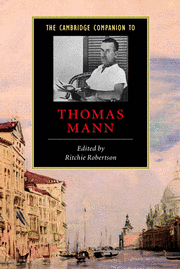Book contents
- Frontmatter
- 1 Mann and history
- 2 The intellectual world of Thomas Mann
- 3 Mann's literary techniques
- 4 Mann's man's world
- 5 Mann's early novellas
- 6 Classicism and its pitfalls
- 7 The political becomes personal
- 8 Buddenbrooks
- 9 The Magic Mountain
- 10 Religion and culture
- 11 Doctor Faustus
- 12 Lotte in Weimar
- 13 The Confessions of Felix Krull, Confidence Man
- 14 Mann as essayist
- 15 Mann as diarist
- 16 Mann in English
- Bibliography
- Index
11 - Doctor Faustus
Published online by Cambridge University Press: 28 May 2006
- Frontmatter
- 1 Mann and history
- 2 The intellectual world of Thomas Mann
- 3 Mann's literary techniques
- 4 Mann's man's world
- 5 Mann's early novellas
- 6 Classicism and its pitfalls
- 7 The political becomes personal
- 8 Buddenbrooks
- 9 The Magic Mountain
- 10 Religion and culture
- 11 Doctor Faustus
- 12 Lotte in Weimar
- 13 The Confessions of Felix Krull, Confidence Man
- 14 Mann as essayist
- 15 Mann as diarist
- 16 Mann in English
- Bibliography
- Index
Summary
Thomas Mann began work on Doctor Faustus in May 1943, having just completed Joseph and his Brothers. A year earlier, as he was putting the finishing touches to the biblical tetralogy, he found his thoughts already turning towards this next novel, a daring new artist's tale that might, he believed, be the most bizarre and outlandish he had ever produced. A month before beginning the book Mann disclosed what he had in mind: to take up a project he had conceived as early as 1904, the story of an artist in league with the devil for the sake of creativity, a modern-day Faust who would sell his soul to make wondrous works of art (letters to Agnes E. Meyer, 21 February 1942, and to Klaus Mann, 27 April 1943). Art and artistry were of course familiar concerns for Mann, but why, we might ask, would he choose just now in the middle of the Second World War to devote an ambitious new novel to the tribulations of the artist? Living in exile along with other refugees in the United States, Mann was following the progress of Hitler's war with the distress of a German worried about the guilt and fate of his people. With the popularity of his translated works in America, moreover, he was becoming a prominent spokesperson on the German issue. Surely this was not the moment for him to rework the predicament of Tonio Kröoger, Gustav Aschenbach, and the other frustrated artists who populate his tales, a strangely intellectual topic given the atrocities taking place in Europe. The author would have to make himself clear.
- Type
- Chapter
- Information
- The Cambridge Companion to Thomas Mann , pp. 168 - 184Publisher: Cambridge University PressPrint publication year: 2001
- 2
- Cited by



